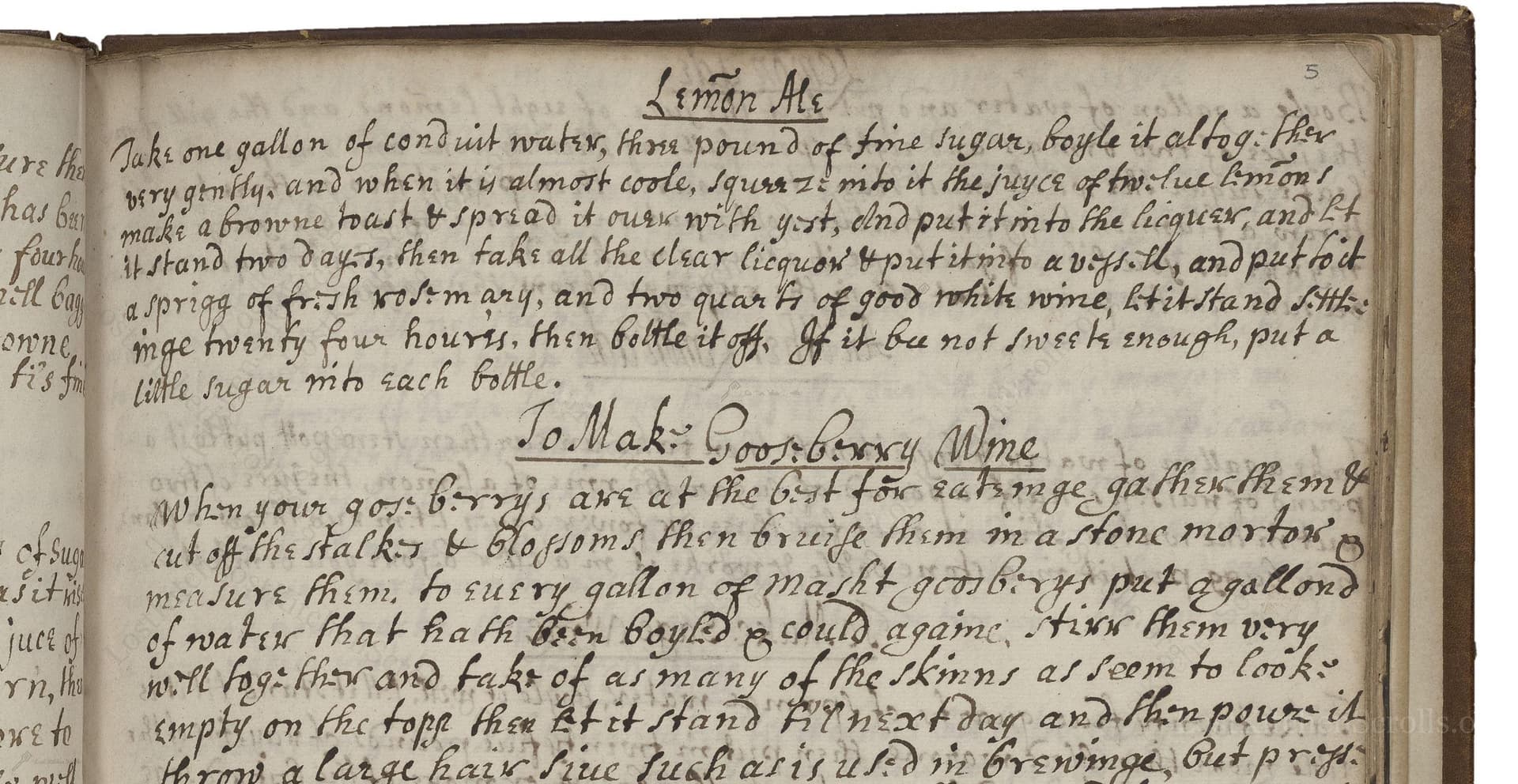Lemon Ale
From the treasured pages of Receipts in cookery and medicine 1700
Unknown Author

Lemon Ale
"Take one gallon of conduit water, three pounds of fine sugar, boyle it altogether very gently; and when it is almost coole, squeese into it the juyce of twelue lemons make a browne toast & spred it ouer with yest, and put it into the licquor, and let it stand two days, then take all the clear licquor & put it into a vessil, and put to it a sprigg of fresh rosemary, and two quarts of good white wine, let it stand little more twenty four houres, then bottle it off. if it be not sweet enough, put a little sugar into each bottle."
Note on the Original Text
The recipe is written in a straightforward, instruction-driven manner, typical of early modern English household manuscripts. Spelling follows 17th-century conventions ('boyle' for 'boil', 'licquor' for 'liquor', 'squeese' for 'squeeze', 'ouer' for 'over', 'vessil' for 'vessel'), and punctuation is minimal. There is an assumption of basic kitchen knowledge. Quantities are sometimes imprecise and instructions rely on sensory cues rather than exact times or temperatures, reflecting a cook’s hands-on familiarity with the process rather than reliance on timers or thermometers.

Title
Receipts in cookery and medicine 1700 (1700)
You can also click the book image above to peruse the original tome
Writer
Unknown
Era
1700
Publisher
Unknown
Background
Step into the kitchen of the early 18th century, where this charming culinary manuscript tempts tastebuds with recipes and secrets from a bygone era. A delicious journey for both the curious cook and the history lover.
Kindly made available by
Folger Shakespeare Library
This recipe dates from around 1700, a period when homemade fermented beverages were common household fare in England. Lemon ale was a fashionable refreshment—something that would have graced the tables of well-to-do families or been shared in convivial gatherings. It represents the English tradition of blending native fermentation skills with exotic citrus, which became increasingly popular during this era thanks to global trade. Recorded in the manuscript 'V.b.273,' this recipe allowed homemakers to create a bright, effervescent drink using relatively accessible ingredients, providing a zesty alternative to stronger ales or wines.

Back in the early 18th century, the recipe would have been prepared using a large copper or earthenware kettle for heating the sugar-water, a hearth or open fire for toasting bread, simple wooden or pewter spoons for stirring, and muslin cloths or sieves for straining. Fermentation would occur in a stoneware or glass vessel covered loosely with cloth to keep out insects while allowing air circulation. Bottling was typically done into heavy glass bottles closed with corks or wax seals.
Prep Time
30 mins
Cook Time
10 mins
Servings
18
We've done our best to adapt this historical recipe for modern kitchens, but some details may still need refinement. We warmly welcome feedback from fellow cooks and culinary historians — your insights support the entire community!
Ingredients
- 1 gallon plus 3 cups fresh water (filtered or spring)
- 3 lbs fine white sugar
- Juice of 12 lemons (approximately 1 2/3 to 2 cups)
- 1 slice of rustic bread (about 3/4 inch thick), toasted
- 2 teaspoons baker’s yeast (or use brewers yeast for less yeasty flavor)
- 1 fresh sprig rosemary
- 2 quarts good dry white wine
- Additional sugar (to taste, for bottling)
Instructions
- Begin by heating 1 gallon plus 3 cups of fresh water with 3 lbs of fine white sugar in a large pot, bringing it to a gentle simmer until the sugar is fully dissolved.
- Allow it to cool until just warm to the touch, then add the freshly squeezed juice of 12 lemons (about 1 2/3 to 2 cups).
- Toast a thick slice of good bread to a deep golden brown, spread it liberaly with about 2 teaspoons of baker’s yeast, and float it on the surface of the cooled lemon-sugar water.
- Cover loosly and let the mixture ferment at room temperature for 48 hours.
- After that, strain the liquid through a fine sieve or muslin to remove the solids, then pour the clear liquid into a large, clean vessel.
- Add a fresh sprig of rosemary and 2 quarts (about 2 1/8 quarts) of dry white wine.
- Leave to infuse for another 24 hours.
- Finally, bottle your lemon ale, adding a little extra sugar (about 1 teaspoon) to each bottle if you prefer it sweeter.
- Cap tightly and store in a cool place.
- Serve lightly chilled for a refreshing historical tipple.
Estimated Calories
210 per serving
Cooking Estimates
It takes about 30 minutes to prepare the ingredients and toast the bread. Cooking is just dissolving sugar in water, which takes around 10 minutes. Fermenting and infusion require waiting, but need little hands-on work. Each serving has roughly 210 calories, and the recipe makes about 18 servings.
As noted above, we have made our best effort to translate and adapt this historical recipe for modern kitchens, taking into account ingredients nowadays, cooking techniques, measurements, and so on. However, historical recipes often contain assumptions that require interpretation.
We'd love for anyone to help improve these adaptations. Community contributions are highly welcome. If you have suggestions, corrections, or cooking tips based on your experience with this recipe, please share them below.
Join the Discussion
Rate This Recipe
Dietary Preference
Main Ingredients
Occasions

Den Bockfisch In Einer Fleisch Suppen Zu Kochen
This recipe hails from a German manuscript cookbook compiled in 1696, a time whe...

Die Grieß Nudlen Zumachen
This recipe comes from a rather mysterious manuscript cookbook, penned anonymous...

Ein Boudain
This recipe comes from an anonymous German-language manuscript cookbook from 169...

Ein Gesaltzen Citroni
This recipe, dating from 1696, comes from an extensive anonymous German cookbook...
Browse our complete collection of time-honored recipes



